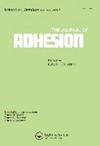干燥条件对压敏粘合剂粘合强度的影响
IF 2.3
4区 材料科学
Q2 ENGINEERING, CHEMICAL
引用次数: 0
摘要
本文章由计算机程序翻译,如有差异,请以英文原文为准。
Effect of drying conditions on adhesion strength of a pressure-sensitive adhesive
ABSTRACT Regular surface roughness could be created on the surface of a pressure-sensitive adhesive (PSA) film through Marangoni flow during the drying process. Therefore, tailoring of both surface and bulk characteristics of the PSA and consequently its adhesion strength could be expected by controlling the drying conditions. Herein, surface and bulk properties of a water-based PSA dried at various temperatures and humidities were scrutinized. Increase in the drying temperature improved the adhesion strength of the PSA to poly(ethylene terephthalate) due to enhanced surface nanoroughness of its film. At constant humidity, the higher the Péclet number, the higher the Marangoni number and the rougher the PSA film surface. Drying humidity rise, however, improved the adhesion strength due to more uniform distribution of copolymers constituting the PSA, better interdiffusion of chains through the interface of polymer particles in a prolonged drying process, and increased surface free energy of the film. The adhesion strength of the PSA, similar to the here-defined viscoelastic dissipation ability, demonstrated a power dependence on the film surface nanoroughness. This newly-defined parameter considers taking advantage of the real viscoelastic dissipation of the PSA regarding its potentiality through thorough wetting of the substrate surface with the PSA.
求助全文
通过发布文献求助,成功后即可免费获取论文全文。
去求助
来源期刊

Journal of Adhesion
工程技术-材料科学:综合
CiteScore
5.30
自引率
9.10%
发文量
55
审稿时长
1 months
期刊介绍:
The Journal of Adhesion is dedicated to perpetuating understanding of the phenomenon of adhesion and its practical applications. The art of adhesion is maturing into a science that requires a broad, coordinated interdisciplinary effort to help illuminate its complex nature and numerous manifestations.
 求助内容:
求助内容: 应助结果提醒方式:
应助结果提醒方式:


